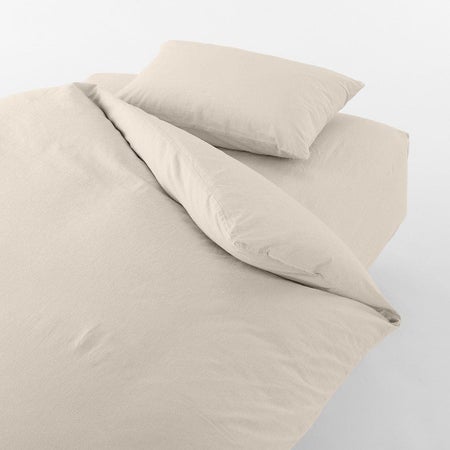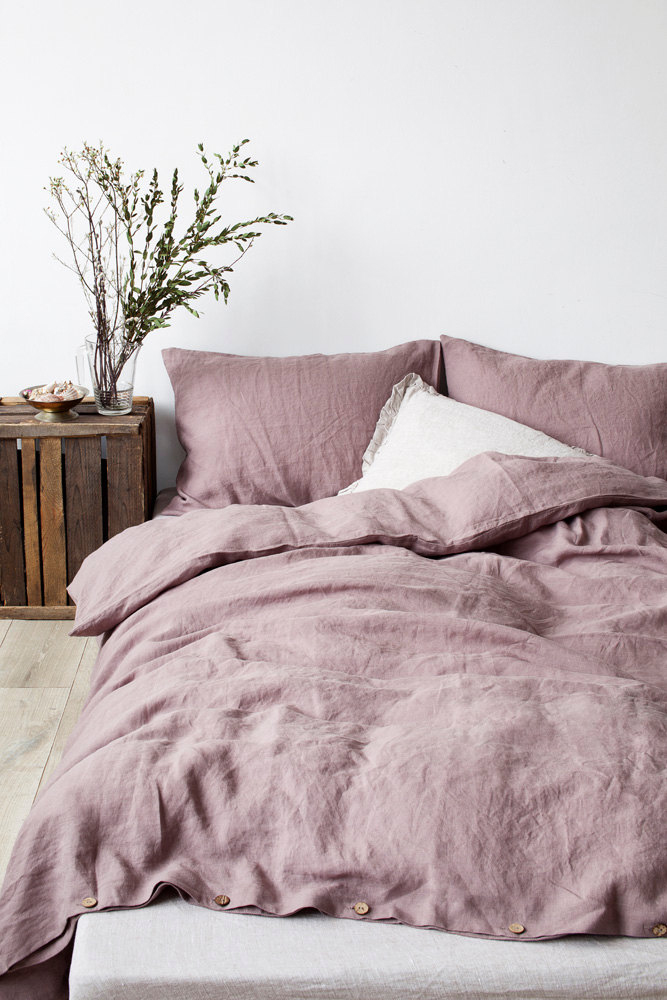Understanding Linen: The Eco-Friendly Alternative for Comfy Living
When you believe concerning environmentally friendly materials, linen commonly stands out for its unique high qualities. What really sets bed linen apart from various other products? Let's discover the remarkable world of bed linen better.
The Origins of Linen: From Flax to Textile

Linen, one of the earliest fabrics understood to humanity, has a fascinating journey that starts with the simple flax plant. Once collected, the flax stalks undertake a process called retting, where they're saturated to separate the fibers from the woody parts.
When you see linen material, you're observing centuries of craftsmanship. The weaving procedure transforms those spools of thread right into the stunning, sturdy cloth you enjoy. Linen has been treasured for its natural look and feel, making it a favorite for whatever from apparel to home textiles. Next time you touch linen, remember its abundant history that connects you to ancient societies and their conventional techniques.
The Distinct Feature of Linen
Among the standout attributes of this remarkable textile is its breathability. When you use bed linen, you'll notice just how it enables air to circulate, maintaining you cool down on warm days. This home makes it an ideal selection for summer clothes and bedding.
Bed linen additionally flaunts outstanding moisture-wicking capabilities, pulling sweat far from your skin and permitting it to vaporize rapidly. You will not feel clammy, even in humid conditions. Additionally, linen is resilient, frequently coming to be softer and extra comfy with each wash, which implies it can stand the test of time in your closet.
One more one-of-a-kind facet is its all-natural texture; the small abnormalities give linen a character that enhances your style. And also, it withstands wrinkles much better than several various other textiles, so you can enjoy a loosened up yet polished appearance without much effort. Embrace bed linen, and you'll appreciate its convenience and special appeal.
Environmental Benefits of Linen
When you choose bed linen, you're not simply selecting a stunning textile; you're also sustaining sustainable production techniques. Bed linen's compostable and naturally degradable nature makes it a wise choice for the environment. Plus, it calls for considerably less water to produce contrasted to various other textiles, helping conserve this valuable source.
Sustainable Manufacturing Practices
Although several fabrics have considerable environmental influences, bed linen stands out due to its sustainable production techniques. When you pick linen, you're deciding for a material made from the flax plant, which needs minimal water and chemicals.
Bed linen production is often much less energy-intensive contrasted to other textiles, as it includes natural procedures rather than artificial treatments. By sustaining bed linen, you're adding to a much more sustainable fabric industry that focuses on green techniques. Selecting bed linen not just improves your comfort but additionally aligns your values with environmental duty.
Naturally degradable and Compostable Material
Bed linen's eco-friendly nature extends beyond its sustainable manufacturing; it's compostable and also eco-friendly, making it an excellent option for eco aware consumers. When you choose bed linen products, you're choosing for materials that break down normally, returning nutrients to the earth. Composting linen can enrich soil, advertising healthy and balanced plant growth.
Low Water Usage
One of the standout advantages of bed linen is its reduced water usage during growing. Unlike cotton, which requires significant irrigation, bed linen's flax plant thrives on very little water, making it an extra sustainable selection. You'll appreciate knowing that for every single lot of linen produced, considerably less water is needed contrasted to numerous other fabrics. This means that picking bed linen assists save crucial freshwater resources, which is necessary in today's climate. Furthermore, bed linen's natural drought resistance permits it to expand in less-than-ideal problems, better lowering its ecological influence. By selecting linen, you're not simply buying quality; you're also sustaining a fabric that promotes responsible water usage and adds to a much healthier world for future generations.
Bed linen vs. Various Other Fabrics: A Comparison
When you contrast linen to other textiles, you'll observe its superior breathability and comfort, making it perfect for warm climate. And also, bed linen sticks out for its resilience and durability, typically lasting longer than numerous commonly used products. As you consider your selections, the environmental effect of each textile will additionally play a crucial duty in your choice.
Breathability and Comfort
Breathability is a crucial variable in choosing fabrics for comfort, specifically in cozy weather condition. Bed linen stands apart among materials for its remarkable ability to permit air flow. Unlike find out this here artificial textiles, which can catch warm and moisture, linen's natural fibers wick away sweat, keeping you completely dry and trendy. When you put on bed linen, you'll see how it feels light versus your skin, improving your comfort during warm days.
Cotton is commonly commended for its softness, yet it doesn't match bed linen's breathability. If you focus on convenience, especially in summer season, linen should be your best selection.
Sturdiness and Durability
While several textiles supply varying levels of longevity, bed linen really succeeds in longevity, making it a smart investment for your closet. Unlike cotton or artificial materials that may wear out promptly, linen gets stronger with each laundry. You'll locate that linen's breathable nature also reduces wear from sweat and wetness, which can damage various other materials.
Environmental Influence Comparison
Although many textiles add to environmental issues, bed linen sticks out for its environment-friendly qualities. Unlike cotton, which needs huge water resources and chemicals, bed linen is made from flax, a plant that flourishes on minimal water and requires less chemicals. This implies you can really feel great about your selection while lowering your carbon impact.
When compared to synthetic textiles like polyester, bed linen's biodegradability beams. While polyester can take centuries to disintegrate, linen breaks down naturally, returning nutrients to the dirt.
Picking linen not just promotes sustainable farming practices but likewise sustains a much healthier planet. By selecting bed linen over standard materials, you're making a conscious choice that benefits both your comfort and the environment.
Caring for Your Bed Linen Textiles
To guarantee your linen textiles stay in terrific problem, you'll want to adhere to some straightforward treatment guidelines. Clean your linen in chilly water on a mild cycle to avoid it from shrinking or losing its form.
When it comes to drying, air drying out is ideal. If you use a dryer, select a reduced warm setup and eliminate the items while they're still somewhat damp to lessen wrinkles. Iron the bed linen while it's still damp for less complicated handling, or steam it to maintain it looking crisp.
For storage space, maintain your visit linen in an awesome, dry place. Prevent direct sunlight to stop fading. With these straightforward practices, your linen textiles will certainly preserve their charm and last for several years, making them a sustainable enhancement to your lifestyle.
Integrating Bed Linen Into Your Home Style
Caring for your linen fabrics not only preserves their quality yet also opens up a globe of possibilities for including them right into your home décor. You can start tiny by adding linen toss cushions to your couch, quickly elevating the room with structure and heat. Think about linen curtains that filter sunlight perfectly, developing a soft, airy ambience in any kind of space.
For a much more rustic look, try using linen tablecloths or joggers throughout meals; they include an elegant touch and are very easy to tidy. If you're really feeling daring, mix and match various linen shades and patterns to create an unique, split result.
Do not ignore linen coverings-- drape one over a chair or your bed for an inviting feeling. By thoughtfully incorporating linen right into your decoration, you enhance both comfort and design, making your home a peaceful retreat.
The Future of Linen in Lasting Living
As consumers progressively focus on sustainability, linen arises as a frontrunner in green textiles. Its manufacturing uses much less water and chemicals contrasted to conventional cotton, making it a more environmentally accountable selection. As you look towards a lasting future, incorporating linen right into your closet and home can significantly reduce your carbon impact.
Ingenious brands are now concentrating on sustainable methods, from using organic flax to applying circular economic situation concepts. You'll find that bed linen's sturdiness implies it lasts longer, reducing the demand for frequent replacements.
Moreover, as more individuals embrace minimalist lifestyles, linen's ageless appeal and flexibility will certainly maintain it relevant. By go to my site picking linen, you're not just choosing comfort; you're also supporting sustainable techniques.
In the upcoming years, the demand for bed linen is anticipated to expand, strengthening its location in a more eco-conscious world. So, consider making linen a staple in your lasting living journey.
Often Asked Concerns
Is Linen Suitable for Individuals With Allergic Reactions?
Yes, linen's natural fibers are hypoallergenic, making it suitable for individuals with allergic reactions. Its breathable nature helps in reducing dampness and bacteria buildup, contributing to a healthier resting atmosphere. You'll likely find it safe and comfy.
Can Linen Be Dyed Quickly?
Yes, you can color bed linen easily. Its natural fibers absorb dyes well, permitting dynamic shades. Just ensure you utilize the appropriate dye kind and comply with correct strategies to achieve the desired outcomes without damaging the material.
Exactly How Does Linen Compare in Resilience to Cotton?

What Weight of Bed Linen Is Ideal for Summer Season Clothes?
For summer season clothes, lightweight bed linen around 4 to 5 ounces per yard is excellent. It keeps you amazing, breathable, and comfortable in heat (Linen Australia). You'll value how it drapes and relocations with you easily

Can Linen Be Utilized for Outdoor Furniture?
Yes, you can utilize bed linen for outside furniture. It's resilient and breathable, making it a great selection for warm weather. Simply make sure to select a treated variation to hold up against the aspects and maintain its appearance.
Verdict
Incorporating linen right into your life not just improves your convenience however additionally sustains a much more lasting future. With its special residential or commercial properties and very little environmental influence, bed linen is a smart option for your home decoration and way of life.
Linen's naturally degradable and compostable nature makes it a smart option for the setting. By integrating linen into your home, you're not just appreciating its comfort and longevity; you're also helping and sustaining environment-friendly techniques develop a healthier earth. The Future of Bed Linen in Sustainable Living.
